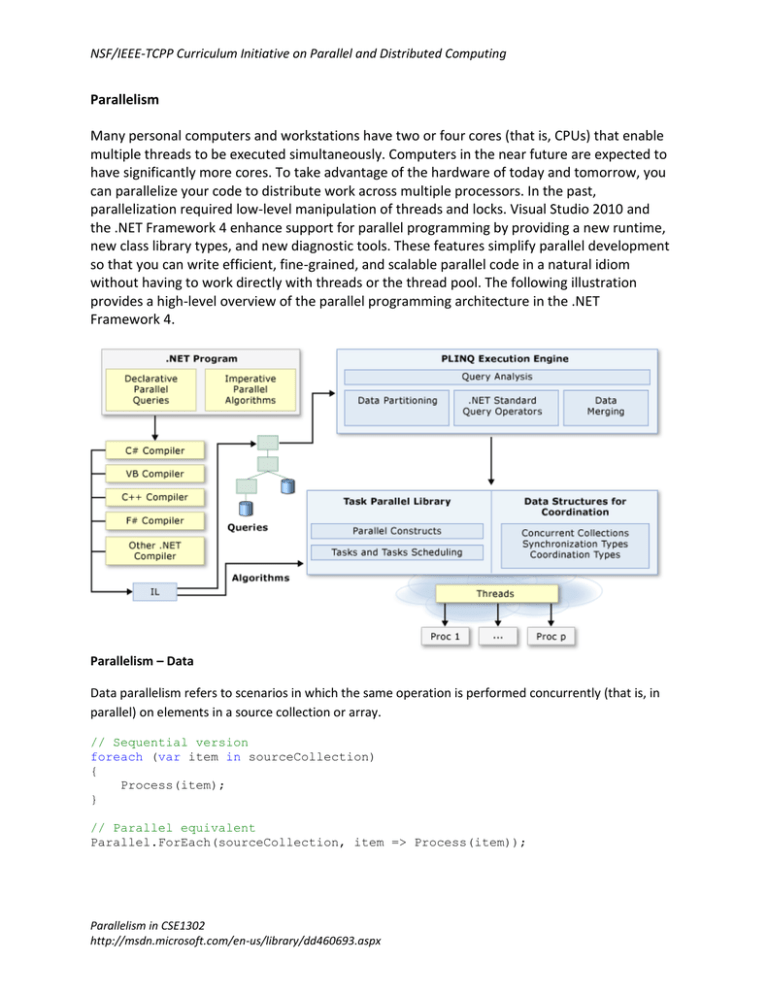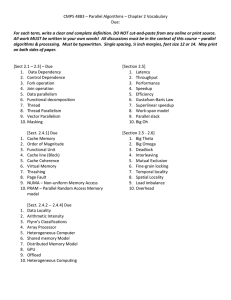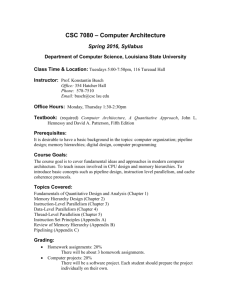Parallelism - 1302.docx
advertisement

NSF/IEEE-TCPP Curriculum Initiative on Parallel and Distributed Computing
Parallelism
Many personal computers and workstations have two or four cores (that is, CPUs) that enable
multiple threads to be executed simultaneously. Computers in the near future are expected to
have significantly more cores. To take advantage of the hardware of today and tomorrow, you
can parallelize your code to distribute work across multiple processors. In the past,
parallelization required low-level manipulation of threads and locks. Visual Studio 2010 and
the .NET Framework 4 enhance support for parallel programming by providing a new runtime,
new class library types, and new diagnostic tools. These features simplify parallel development
so that you can write efficient, fine-grained, and scalable parallel code in a natural idiom
without having to work directly with threads or the thread pool. The following illustration
provides a high-level overview of the parallel programming architecture in the .NET
Framework 4.
Parallelism – Data
Data parallelism refers to scenarios in which the same operation is performed concurrently (that is, in
parallel) on elements in a source collection or array.
// Sequential version
foreach (var item in sourceCollection)
{
Process(item);
}
// Parallel equivalent
Parallel.ForEach(sourceCollection, item => Process(item));
Parallelism in CSE1302
http://msdn.microsoft.com/en-us/library/dd460693.aspx
NSF/IEEE-TCPP Curriculum Initiative on Parallel and Distributed Computing
When a parallel loop runs, the TPL partitions the data source so that the loop can operate on multiple
parts concurrently. Behind the scenes, the Task Scheduler partitions the task based on system resources
and workload. When possible, the scheduler redistributes work among multiple threads and processors
if the workload becomes unbalanced.
Parallelism - Task
The Task Parallel Library (TPL), as its name implies, is based on the concept of the task. The
term task parallelism refers to one or more independent tasks running concurrently. A task
represents an asynchronous operation, and in some ways it resembles the creation of a new
thread or ThreadPool work item, but at a higher level of abstraction. Tasks provide two primary
benefits:
More efficient and more scalable use of system resources.
Behind the scenes, tasks are queued to the ThreadPool, which has been enhanced with
algorithms (like hill-climbing) that determine and adjust to the number of threads that
maximizes throughput. This makes tasks relatively lightweight, and you can create many
of them to enable fine-grained parallelism. To complement this, widely-known workstealing algorithms are employed to provide load-balancing.
More programmatic control than is possible with a thread or work item.
Tasks and the framework built around them provide a rich set of APIs that support
waiting, cancellation, continuations, robust exception handling, detailed status, custom
scheduling, and more.
Parallel.Invoke(() => DoSomeWork(), () => DoSomeOtherWork());
Parallelism – Coordination
Typically, you would wait for a task for one of these reasons:
The main thread depends on the final result computed by a task.
You have to handle exceptions that might be thrown from the task.
Task[] tasks = new Task[3]
{
Task.Factory.StartNew(() => MethodA()),
Task.Factory.StartNew(() => MethodB()),
Task.Factory.StartNew(() => MethodC())
};
//Block until all tasks complete.
Task.WaitAll(tasks);
// Continue on this thread...
Parallelism in CSE1302
http://msdn.microsoft.com/en-us/library/dd460693.aspx





